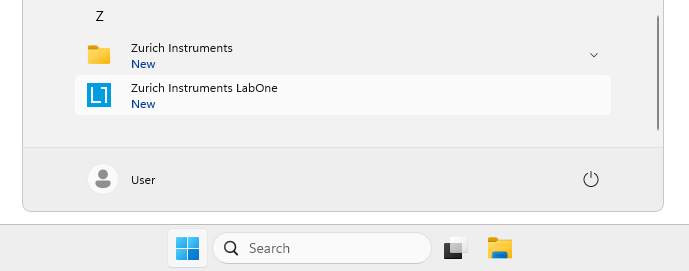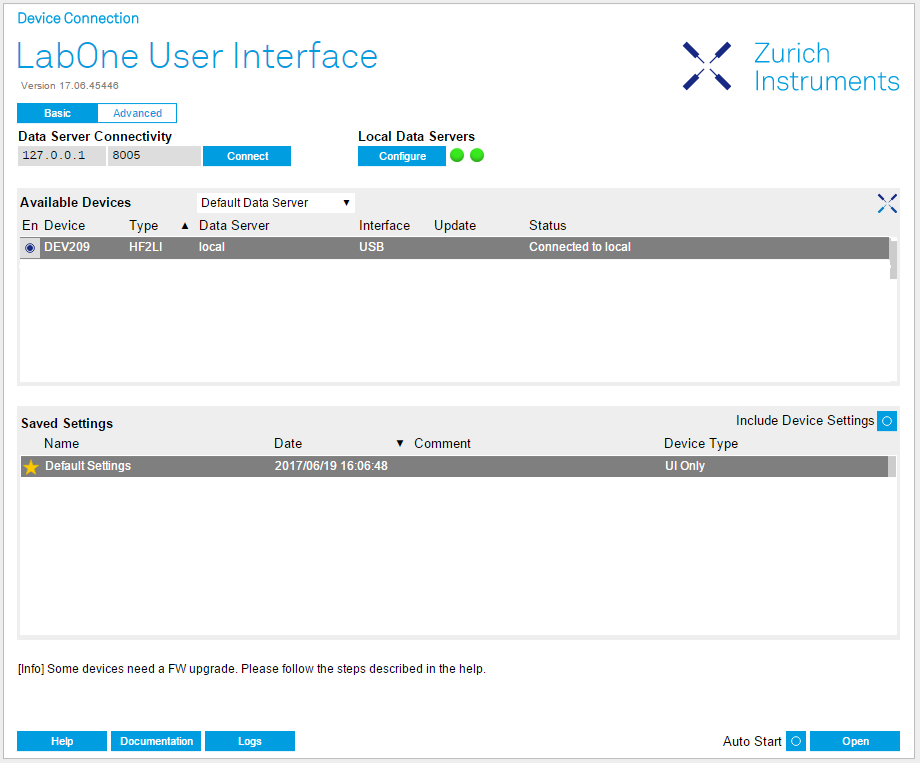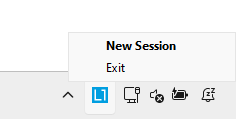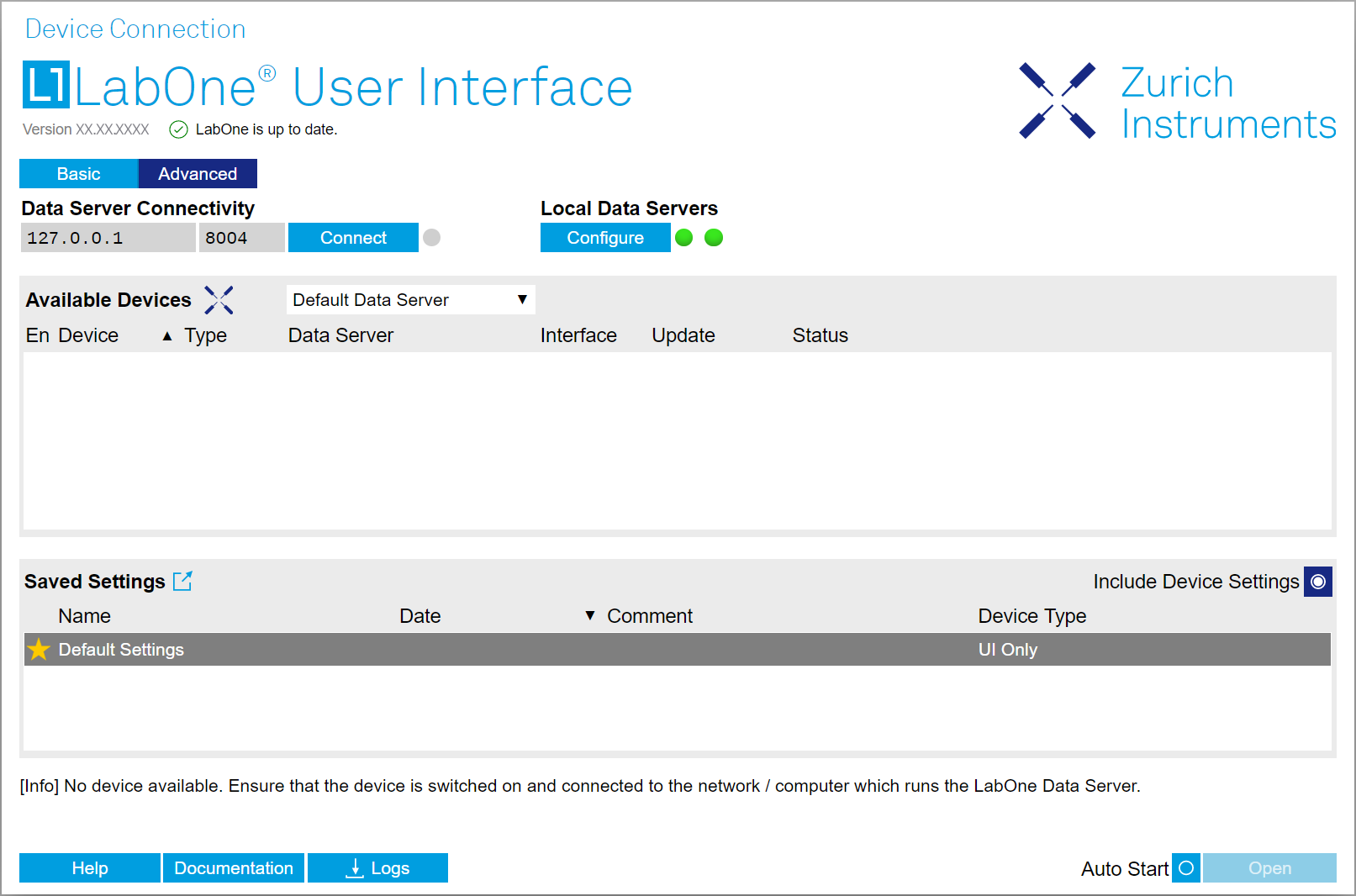Connecting to the Instrument¶
The Zurich Instruments HF2LI Instrument is operated using the LabOne software. After installation of LabOne, the instrument is ready to be connected to a PC by the USB cable. The LabOne software is controlled via a web browser once suitable physical and logical connections to the instrument have been made.
LabOne Software Architecture¶
The Zurich Instruments LabOne software gives quick and easy access to the instrument from a host PC. LabOne also supports advanced configurations with simultaneous access by multiple software clients (i.e., LabOne User Interface clients and/or API clients), and even simultaneous access by several users working on different computers. Here we give a brief overview of the architecture of the LabOne software. This will help to better understand the following chapters.
The software of Zurich Instruments equipment is server-based. The servers and other software components are organized in layers as shown in Figure 1.
- The lowest layer running on the PC is the LabOne Data Server, which is the interface to the connected instrument.
- The middle layer contains the LabOne Web Server, which is the server for the browser-based LabOne User Interface.
- The graphical user interface, together with the programming user interfaces, are contained in the top layer.
The architecture with one central Data Server allows multiple clients to access a device with synchronized settings. The following sections explain the different layers and their functionality in more detail.

LabOne Data Server¶
The LabOne Data Server program is a dedicated server that is in charge of all communication to and from the device. The Data Server can control a single or also multiple instruments. It will distribute the measurement data from the instrument to all the clients that subscribe to it. It also ensures that settings changed by one client are communicated to other clients. The device settings are therefore synchronized on all clients. The HF2 Data Server is started automatically (on Windows via ziService, on Linux via udev) whenever a HF2 Instrument is connected to a PC via USB. On a PC, only a single instance of a LabOne Data Server should be running.
LabOne Web Server¶
The LabOne Web Server is an application dedicated to serving up the web pages that constitute the LabOne user interface. The user interface can be opened with any device with a web browser. Since it is touch enabled, it is possible to work with the LabOne User Interface on a mobile device - like a tablet. The LabOne Web Server supports multiple clients simultaneously. This means that more than one session can be used to view data and to manipulate the instrument. A session could be running in a browser on the PC on which the LabOne software is installed. It could equally well be running in a browser on a remote machine.
With a LabOne Web Server running and accessing an instrument, a new session can be opened by typing in a network address and port number in a browser address bar. In case the Web Server runs on the same computer, the address is the localhost address (both are equivalent):
127.0.0.1:8006localhost:8006
In case the Web Server runs on a remote computer, the address is the IP address or network name of the remote computer:
192.168.x.y:8006myPC.company.com:8006
The most recent versions of the most popular browsers are supported: Chrome, Firefox, Edge, Safari and Opera.
LabOne API Layer¶
The instrument can also be controlled via the application program interfaces (APIs) provided by Zurich Instruments. APIs are provided in the form of DLLs for the following programming environments:
- MATLAB
- Python
- LabVIEW
- .NET
- C
The instrument can therefore be controlled by an external program, and the resulting data can be processed there. The device can be concurrently accessed via one or more of the APIs and via the user interface. This enables easy integration into larger laboratory setups. See the LabOne Programming Manual for further information. Using the APIs, the user has access to the same functionality that is available in the LabOne User Interface.
LabOne Software Start-up¶
This section describes the start-up of the LabOne User Interface which is used to control the HF2 Series Instrument. If the LabOne software is not yet installed on the PC please follow the instructions in Software Installation. If the device is not yet connected please find more information in Visibility and Connection.
The LabOne User Interface start-up link can be found under the Windows
10/11 Start Menu. As
shown in Figure 2, click on
Start Menu → Zurich Instruments LabOne. This will open the User
Interface in a new tab in your default web browser and start the LabOne
Data Server and LabOne Web Server programs in the background. A detailed
description of the software architecture is found in LabOne Software
Architecture.

LabOne is an HTML5 browser-based program. This simply means that the user interface runs in a web browser and that a connection using a mobile device is also possible; simply specify the IP address (and port 8006) of the PC running the user interface.
Note
By creating a shortcut to Google Chrome on your desktop with the Target
path\to\chrome.exe -app=http://127.0.0.1:8006 set in Properties you
can run the LabOne User Interface in Chrome in application mode, which
improves the user experience by removing the unnecessary browser
controls.
After starting LabOne, the Device Connection dialog Figure 3 is shown to select the device for the session. The term "session" is used for an active connection between the user interface and the device. Such a session is defined by device settings and user interface settings. Several sessions can be started in parallel. The sessions run on a shared LabOne Web Server. A detailed description of the software architecture can be found in the LabOne Software Architecture.

The Device Connection dialog opens in the Basic view by default. In this
view, all devices that are available for connection are represented by
an icon with serial number and status information. If required, a button
appears on the icon to perform a firmware upgrade. Otherwise, the device
can be connected by a double click on the icon, or a click on the  button at the bottom right of the dialog.
button at the bottom right of the dialog.
In some cases it’s useful to switch to the Advanced view of the Device Connection dialog by clicking on the "Advanced" button. The Advanced view offers the possibility to select custom device and UI settings for the new session and gives further connectivity options that are particularly useful for multi-instrument setups.

The Advanced view consists of three parts:
- Data Server Connectivity
- Available Devices
- Saved Settings
The Available Devices table has a display filter, usually set to Default Data Server, that is accessible by a drop-down menu in the header row of the table. When changing this to Local Data Servers, the Available Devices table will show only connections via the Data Server on the host PC and will contain all instruments directly connected to the host PC via USB or to the local network via 1GbE. When using the All Data Servers filter, connections via Data Servers running on other PCs in the network also become accessible. Once your instrument appears in the Available Devices table, perform the following steps to start a new session:
-
Select an instrument in the Available Devices table.
-
Select a setting file in the Saved Settings list unless you would like to use the Default Settings.
Note
By default, opening a new session will only load the UI settings (such as plot ranges), but not the device settings (such as signal amplitude) from the saved settings file. In order to include the device settings, enable the Include Device Settings checkbox. Note that this can affect existing sessions since the device settings are shared between them.
Note
In case devices from other Zurich Instruments series (UHF, HF2, MF, HDAWG, PQSC, GHF, or SHF) are used in parallel, the list in Available Devices section can contain those as well.
The following sections describe the functionality of the Device Connection dialog in detail.
Data Server Connectivity¶
The Device Connection dialog represents a Web Server. However, on start-up the Web Server is not yet connected to a LabOne Data Server. With the Connect/Disconnect button the connection to a Data Server can be opened and closed.
This functionality can usually be ignored when working with a single HF2 Instrument and a single host computer. Data Server Connectivity is important for users operating their instruments from a remote PC, i.e., from a PC different to the PC on which the Data Server is running or for users working with multiple instruments. The Data Server Connectivity function then gives the freedom to connect the Web Server to one of several accessible Data Servers. This includes Data Servers running on remote computers, and also Data Servers running on an MF Series instrument.
In order to
work with a UHF, HF2, HDAWG, PQSC, GHF, or SHF instrument remotely,
proceed as follows. On the computer directly connected to the instrument
(Computer 1) open a User Interface session and change the Connectivity
setting in the Config tab to "From Everywhere". On the remote computer
(Computer 2), open the Device Connection dialog by starting up the
LabOne User Interface and then go to the Advanced view by clicking on
 on the top left of the dialog. Change the display filter from Default
Data Server to All Data Servers by opening the drop-down menu in the
header row of the Available Devices table. This will make the Instrument
connected to Computer 1 visible in the list. Select the device and
connect to the remote Data Server by clicking on
on the top left of the dialog. Change the display filter from Default
Data Server to All Data Servers by opening the drop-down menu in the
header row of the Available Devices table. This will make the Instrument
connected to Computer 1 visible in the list. Select the device and
connect to the remote Data Server by clicking on  .
Then start the User Interface as described above. In case you use UHF or
MF Instruments in parallel with the HF2, please also refer to the UHF or
MF documentation.
.
Then start the User Interface as described above. In case you use UHF or
MF Instruments in parallel with the HF2, please also refer to the UHF or
MF documentation.
Note
When using the filter "All Data Servers", take great care to connect to the right instrument, especially in larger local networks. Always identify your instrument based on its serial number in the form DEV0000, which can be found on the instrument back panel.
Available Devices¶
The Available Devices table gives an overview of the visible devices. The first column of the list holds the Enable button controlling the connection between the device and a Data Server. For HF2 series instruments, this button is always greyed out since this connection is always established automatically. The second column indicates the serial number and the third column shows the instrument type (HF2, UHF, or MFLI). The fourth column indicates shows the host name of the LabOne Data Server controlling the device. The next column shows the interface type. For HF2 series instruments the type is always USB. The LabOne Data Server will scan for the available devices and interfaces once per second. If a device has just been switched on or physically connected it may take up to 20 s before it becomes visible to the LabOne Data Server. If an interface is physically connected but not visible please read Device Connectivity. The last column indicates the status of the device which in the case of HF2 series instruments is always "Connected"
| Connected | The device is connected to a LabOne Data Server, either on the same PC (indicated as local) or on a remote PC (indicated by its IP address). The user can start a session to work with that device. |
| Free | The device is not in use by any LabOne Data Server and can be connected by clicking the Open button. |
| In Use | The device is in use by a LabOne Data Server. As a consequence the device cannot be accessed by the specified interface. To access the device, a disconnect is needed. |
| Device FW upgrade required/available | The firmware of the device is out of date. Please first upgrade the firmware as described in Software Update. |
| Device not yet ready | The device is visible and starting up. |
Saved Settings¶
Settings files can contain both UI and device settings. UI settings control the structure of the LabOne User Interface, e.g. the position and ordering of opened tabs. Device settings specify the set-up of a device. The device settings persist on the device until the next power cycle or until overwritten by loading another settings file.
The columns are described in Table 2. The table rows can be sorted by clicking on the column header that should be sorted. The default sorting is by time. Therefore, the most recent settings are found on top. Sorting by the favorite marker or setting file name may be useful as well.
Special Settings Files¶
Certain file names have the prefix "last_session_". Such files are created automatically by the LabOne Web Server when a session is terminated either explicitly by the user, or under critical error conditions, and save the current UI and device settings. The prefix is prepended to the name of the most recently used settings file. This allows any unsaved changes to be recovered upon starting a new session.
If a user loads such a last session settings file the "last_session_" prefix will be cut away from the file name. Otherwise, there is a risk that an auto-save will overwrite a setting which was saved explicitly by the user.
The settings file with the name "Default Settings" contains the default UI settings. See button description in Table 3.
| Open | The settings contained in the selected settings file will be loaded. The button "Include Device Settings" controls whether only UI settings are loaded, or if device settings are included. |
| Include Device Settings | Controls which part of the selected settings file is loaded upon clicking on Open. If enabled, both the device and the UI settings are loaded. |
| Auto Start | Skips the session dialog at start-up if selected device is available. The default UI settings will be loaded with unchanged device settings. |
Note
The user setting files are saved to an application-specific folder in the directory structure. The best way to manage these files is using the File Manager tab.
Note
The factory default UI settings can be customized by saving a file with the name "default_ui" in the Config tab once the LabOne session has been started and the desired UI setup has been established. To use factory defaults again, the "default_ui" file must be removed from the user setting directory using the File Manager tab.
Note
Double clicking on a device row in the Available Devices table is a quick way of starting the default LabOne UI. This action is equivalent to selecting the desired device and clicking the Open button.
Double clicking on a row in the Saved Settings table is a quick way of loading the LabOne UI with those UI settings and, depending on the "Include Device Settings" checkbox, device settings. This action is equivalent to selecting the desired settings file and clicking the Open button.
Tray Icon¶
When LabOne is started, a tray icon appears by default in the bottom right corner of the screen, as shown in the figure below. By right-clicking on the icon, a new web server session can be opened quickly, or the LabOne Web and Data Servers can be stopped by clicking on Exit. Double-clicking the icon also opens a new web server session, which is useful when setting up a connection to multiple instruments, for example.

Messages¶
The LabOne Web Server will show additional messages in case of a missing component or a failure condition. These messages display information about the failure condition. The following paragraphs list these messages and give more information on the user actions needed to resolve the problem.
Lost Connection to the LabOne Web Server¶
In this case the browser is no longer able to connect to the LabOne Web Server. This can happen if the Web Server and Data Server run on different PCs and a network connection is interrupted. As long as the Web Server is running and the session did not yet time out, it is possible to just attach to the existing session and continue. Thus, within about 15 seconds it is possible with Retry to recover the old session connection. The Reload button opens the Device Connection dialog shown in Figure 3. The figure below shows an example of the Connection Lost dialog.

Reloading...¶
If a session error cannot be handled, the LabOne Web Server will restart to show a new Device Connection dialog as shown in Figure 3. During the restart a window is displayed indicating that the LabOne User Interface will reload. If reloading does not happen the same effect can be triggered by pressing F5 on the keyboard. The figure below shows an example of this dialog.

No Device Discovered¶
An empty "Available Devices" table means that no devices were discovered. This can mean that no LabOne Data Server is running, or that it is running but failed to detect any devices. The device may be switched off or the interface connection fails. For more information on the interface between device and PC see Visibility and Connection. The figure below shows an example of this dialog.

Device Connectivity¶
The device can be connected to a host computer by Universal Serial Bus (USB).The HF2 Instrument will then connect to the Data Server on the host PC. If the Data Server is not yet up and running, it is started up automatically when plugging in the USB connection. An instrument can be connected to one Data Server only, but a single Data Server and host computer can connect to several instruments at once.
If the host computer is in a local TCP/IP network, it’s possible to control the device remotely and even from several computers simultaneously. Also in this remote configuration, there is a single LabOne Data Server connected to the instrument. This Data Server runs on the computer connected to the instrument via USB. The Data Server can serve one or more remote clients in the network. All clients can access the same measurement data. Changes in instrument settings done by one client will be seen by all other clients.

Figure 9 shows some examples of possible configurations of PC-to-device connectivity.
- Server on PC 1 is connected to device 1 (USB) and device 2 (USB).
- Server on PC 2 is connected to device 3 (USB).
- Server on PC 3 is connected to device 4.
- The devices 1, 2, and 3 are all visible to PC 1 and PC 2 over TCP/IP.

